人教版七年级下册期末U7-U8课件(共36张PPT)
文档属性
| 名称 | 人教版七年级下册期末U7-U8课件(共36张PPT) |  | |
| 格式 | pptx | ||
| 文件大小 | 10.8MB | ||
| 资源类型 | 教案 | ||
| 版本资源 | 人教新目标(Go for it)版 | ||
| 科目 | 英语 | ||
| 更新时间 | 2024-06-07 22:13:13 | ||
图片预览





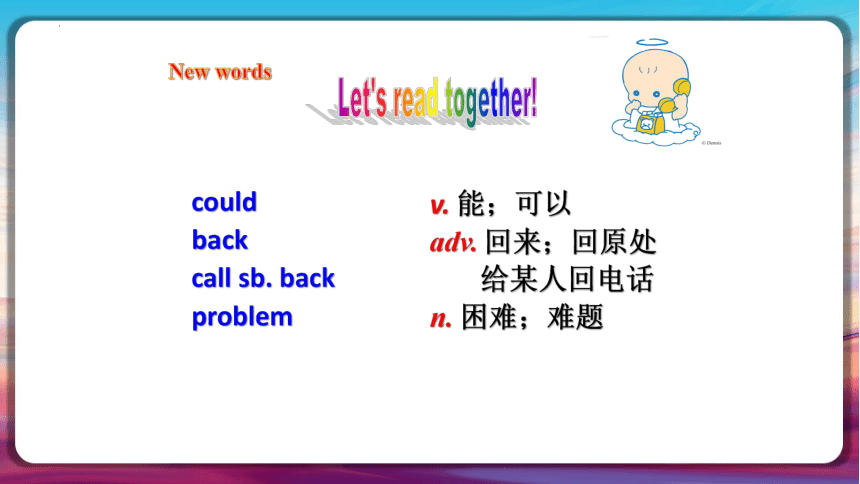
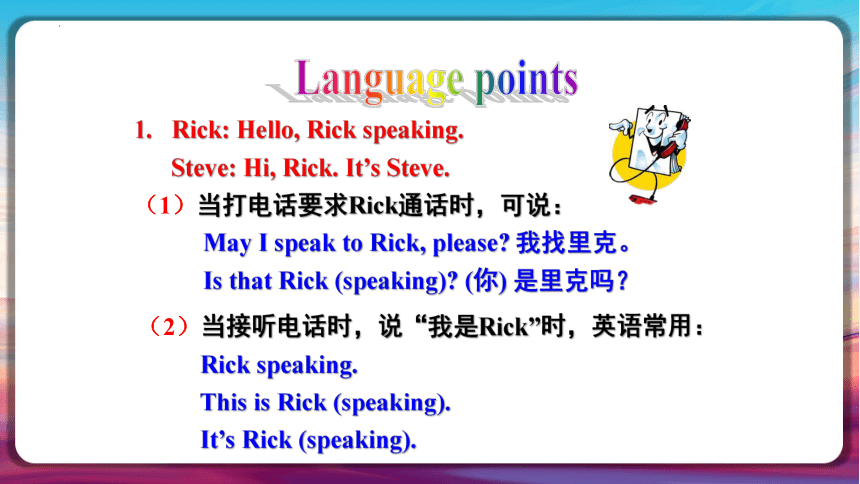

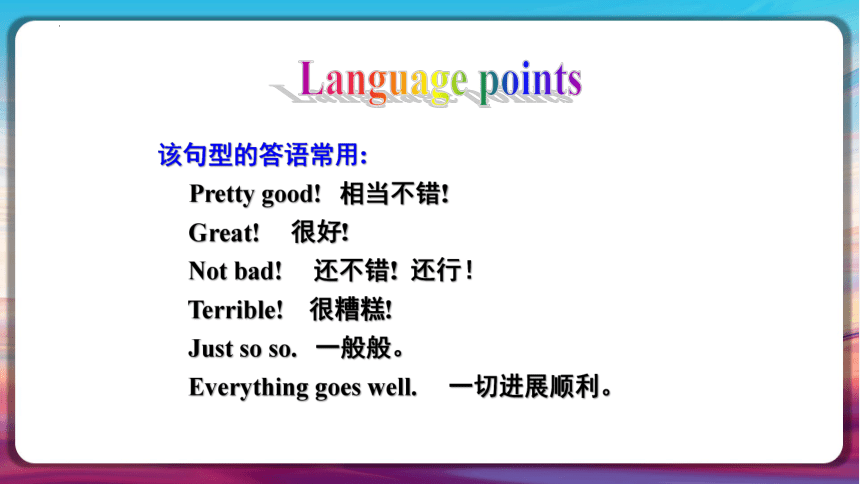

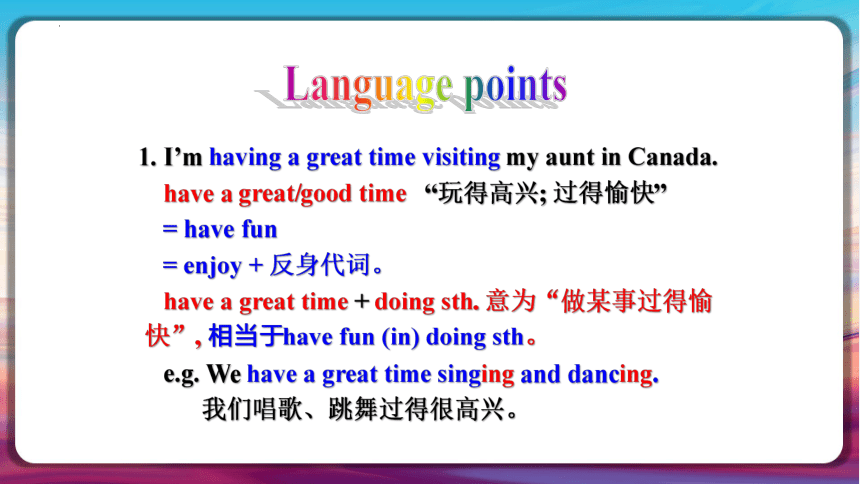
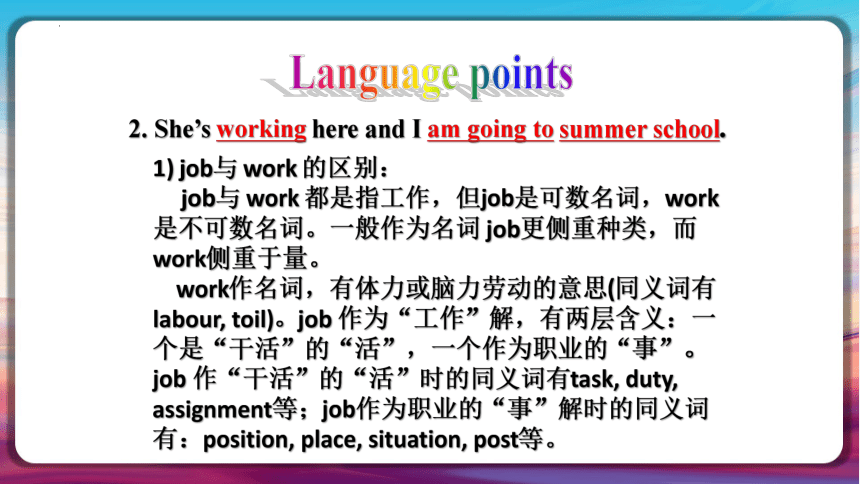
文档简介
(共36张PPT)
2024人教版期末
复习
U7-U8
U7
01
visit
canada
summer
sit
juice
soon
v. 拜访;参观
n. 加拿大
n. 夏天;夏季
v. 坐
n. 果汁;饮料
adv. 不久;很快
New words
Let's read together!
vacation
on (a) vacation
hard
Europe
mountain
country
n. 假期
度假
adv. 努力地 adj. 困难的
n. 欧洲
n. 高山
n. 国;国家
New words
Let's read together!
cook
bad
park
message
take a message
him
n. 厨师 v. 做饭
adj. 坏的;糟糕的
n. 公园
n. 信息;消息
捎口信;传话
pron. 他(宾格)
New words
Let's read together!
could
back
call sb. back
problem
v. 能;可以
adv. 回来;回原处
给某人回电话
n. 困难;难题
New words
Let's read together!
1. Rick: Hello, Rick speaking.
Steve: Hi, Rick. It’s Steve.
(1)当打电话要求Rick通话时,可说:
May I speak to Rick, please 我找里克。
Is that Rick (speaking) (你) 是里克吗?
(2)当接听电话时,说“我是Rick”时,英语常用:
Rick speaking.
This is Rick (speaking).
It’s Rick (speaking).
Language points
2. How’s it going 近来可好?
是英语中用来询问对方近况的寒暄用语,相当于汉语中“近况如何?”“身体可好?”“一切还好吗?”多用于口语或非正式书面场合(如与朋友通信等),后面可跟介词短语with sb./sth.
How’s it going with your summer vacation
= How’s your summer vacation going
你暑假过得怎么样?
Language points
该句型的答语常用:
Pretty good! 相当不错!
Great! 很好!
Not bad! 还不错! 还行!
Terrible! 很糟糕!
Just so so. 一般般。
Everything goes well. 一切进展顺利。
Language points
【拓展】
表达问候还可以用 How are you 进行询问,答语常为“Fine, thank you.”。
这两句话的重点不在于询问,而在于问候或打招呼。
Language points
1. I’m having a great time visiting my aunt in Canada.
have a great/good time “玩得高兴; 过得愉快”
= have fun
= enjoy + 反身代词。
have a great time + doing sth. 意为“做某事过得愉
快”, 相当于have fun (in) doing sth。
e.g. We have a great time singing and dancing.
我们唱歌、跳舞过得很高兴。
Language points
2. She’s working here and I am going to summer school.
1) job与 work 的区别:
job与 work 都是指工作,但job是可数名词,work是不可数名词。一般作为名词 job更侧重种类,而work侧重于量。
work作名词,有体力或脑力劳动的意思(同义词有labour, toil)。job 作为“工作”解,有两层含义:一个是“干活”的“活”,一个作为职业的“事”。job 作“干活”的“活”时的同义词有task, duty, assignment等;job作为职业的“事”解时的同义词有:position, place, situation, post等。
Language points
3. I am studying English and I am learning a lot.
我正学习英语并且我正学的越来越多。
learn “学习,学会”,侧重学习的成果,指从不知到知,从不会到会的学习,强调通过学习去获得知识和技能,它没有凭勤奋努力而获得知识的意味。如 learn music, learn new words
study为“学习,研究”,强调学习的过程,指深入系统地学习,带有努力,勤奋的意味。其学习对象往往是科学,艺术和需要深入探讨,研究的问题及学科,不是单纯地获得技巧。
Language points
4. I am also visiting some of my old friends.
我也看望一些我的老朋友。
visit v. 探望,看望;参观,游览
① visit sb. “拜访某人, 看望某人”
I want to visit my old friends in the US.
② visit sp. “参观某地,游览某地”
I want to visit China next year.
短语:be on a visit to +某地 = visit +某地
He is visiting China. = He is ___ __ _____ to China.
词性转换:visitor (参观者,访问者)
on a visit
Language points
A: ______ the weather
B: It’s ______.
A: What ____ they _______
B: They ____ ________ on the lake.
How’s
sunny
are doing
are boating
Practice
看图片,补全对话。
A: _______ the ________
B: It’s ______.
A: _____ are _____ doing
B: _____ are ________ a _________.
How’s weather
snowy
What they
They making snowman
Practice
看图片,补全对话。
A: _______ the ________
B: It’s ________.
A: _______ is _____ doing
B: ____ is ________ on the _______.
How’s weather
raining
What he
He talking phone
Practice
看图片,补全对话。
A: ______ the weather
B: It’s ______.
A: What ____ they _____
B: They ___ ________.
How’s
sunny
are doing
are painting
看图片,补全对话。
Practice
单项选择
1. - Hello, this is Tim. - ________
A. This is Tom. B. I’m Tom. C. That is Tom. D. Is that Tom
2. Please call her _____ 13345321345.
A. on B. at C. in D. for
3. Can you take a message ______ him?
A. on B. at C. in D. for
4. It _______ he is having a good time.
A. sound good B. sounds good C. sound like D. sounds like
5. Could you ______ her ____ call Tom back
A. want, to B. tell, to C. let, to D. wish, to
Exercises
A
B
D
D
B
U8
02
New words
看图片,说单词!
north
south
east
west
post
office
post office
police
police station
hotel
n. 邮政
n. 办公室
n. 邮局
n. 警察
n. 警察局
n. 旅馆;酒店
New words
Let's read together!
restaurant
bank
hospital
street
pay
pay phone
n. 餐馆
n. 银行
n. 医院
n. 大街
v.& n. 付费
n. 付费电话
New words
Let's read together!
cross与across
1. cross是动词, 意为“横过, 穿过”。
e.g. Cross the street, and you can see a school.
穿过这条街, 你可以看见一所学校。
2. across是介词, 意为“横过, 穿过”, 常和表示位置
移动的动词go, walk, swim等连用。
e.g. He walked across the field.
他走过田地。
Language points
2. in front of... 意为“在……前面”(在某范围之外)
e.g. There is a car in front of the house.
在房子前一辆小汽车。
【辨析】
in the front of... “在……前面”(在某范围之内)
e.g. There is a table in the front of the classroom.
在教室的前面有一张桌子。
Language points
3. next to 意为“紧靠着;紧挨着;贴近”
e.g. The little boy is next to his mother.
小男孩紧挨着他的母亲。
【辨析】next to与near的区别
从空间讲near 只表示“在……附近”;而next to有
“紧挨着”之意;next to比near靠的更近。如:
Peter sits next to Mike.
彼特紧挨着迈克坐。
Language points
Peter sits near Tom.
彼特坐在汤姆附近。
The school is between the hospital and the bank.
学校在医院和银行之间。
She weighs between 55 and 60 kilograms.
她的体重在55公斤到60公斤之间。
4. 介词between意为“在……之间、介于……之间”,
常与and连用,即between …and …,表示“在……
和……之间”。
Language points
(一)意义:
There be 句型也称为“存在句”。意为:在某地有(存在)某物(或某人)
(其中there 是引导词,没有词义;be 是谓语动词,根据主语决定单复数;“某物(某人)” 是主语;“某地”在句子作状语,多用介词短语)
探究乐园
There be 句型
(二)句式结构:
1. 肯定句:There be (is,are) +名词+地点状语
在我的铅笔盒里有两块橡皮。
_____ ___ two erasers in my pencil box.
在房子前有一棵大树。
_____ __ a tall tree in front of the house.
There is
There are
探究乐园
There be 句型
2. 否定句:There isn’t / aren’t + 主语 + 地点。 例如:
大桥街上没有银行。
_____ _____ a bank on Bridge Street.
在教室里没有篮球。
______ _____ any basketballs in the classroom.
There isn’t
There aren’t
探究乐园
There be 句型
3. 一般疑问句:Is/ Are + 主语 +…
肯定回答:Yes, there is/are.
否定回答:No, there isn’t/aren’t.
这附近有餐馆吗?是的。
__ _____ a restaurant near here Yes, there is.
教室里有学生吗?没有。
___ _____ any students in the classroom
No,there aren't.
Is there
Are there
探究乐园
There be 句型
(四)There be 句型中的主谓一致原则
There be句型中be动词的形式要和其后面的主语
在人称和数上保持一致。
(1) 如果句子的主语是单数的可数名词,或是不可数
名词,be动词用“is”。e.g.
_____ __ a pay phone next to the post office.
_____ __ some water in the glass.
There is
探究乐园
There be 句型
There is
(3) 如果有两个或两个以上的名词作主语,be动词要
和最靠近它的那个主语在数上保持一致,也就是我
们常说的 “就近原则”。
e.g. 在桌子上有一只桔子和一些香蕉。
_____ __ an orange and some bananas on the table.
在桌子上有一只桔子和一些香蕉。
_____ ___ some bananas and an orange on the table.
There is
There are
探究乐园
There be 句型
1. There ____ a pen near the ruler.
2. There ____ 2 books on the table.
3. There ____ a pen and two books on the table.
4. There ____ 2 books and a pen on the table.
用be的适当形式填空:
is
are
is
are
语法专项(There be句型)
一、单项填空
1. There ___ a hotel and two restaurants on this street.
A. are B. have C. is D. has
2. ____ a post office in your neighborhood
A. There is B. There are
C. Are there D. Is there
3. — Is there a pay phone near here — Yes, ____.
A. it is B. there is
C. there are D. they are
Exercise
Exercises
Exercise
C
D
B
thanks
2024人教版期末
复习
U7-U8
U7
01
visit
canada
summer
sit
juice
soon
v. 拜访;参观
n. 加拿大
n. 夏天;夏季
v. 坐
n. 果汁;饮料
adv. 不久;很快
New words
Let's read together!
vacation
on (a) vacation
hard
Europe
mountain
country
n. 假期
度假
adv. 努力地 adj. 困难的
n. 欧洲
n. 高山
n. 国;国家
New words
Let's read together!
cook
bad
park
message
take a message
him
n. 厨师 v. 做饭
adj. 坏的;糟糕的
n. 公园
n. 信息;消息
捎口信;传话
pron. 他(宾格)
New words
Let's read together!
could
back
call sb. back
problem
v. 能;可以
adv. 回来;回原处
给某人回电话
n. 困难;难题
New words
Let's read together!
1. Rick: Hello, Rick speaking.
Steve: Hi, Rick. It’s Steve.
(1)当打电话要求Rick通话时,可说:
May I speak to Rick, please 我找里克。
Is that Rick (speaking) (你) 是里克吗?
(2)当接听电话时,说“我是Rick”时,英语常用:
Rick speaking.
This is Rick (speaking).
It’s Rick (speaking).
Language points
2. How’s it going 近来可好?
是英语中用来询问对方近况的寒暄用语,相当于汉语中“近况如何?”“身体可好?”“一切还好吗?”多用于口语或非正式书面场合(如与朋友通信等),后面可跟介词短语with sb./sth.
How’s it going with your summer vacation
= How’s your summer vacation going
你暑假过得怎么样?
Language points
该句型的答语常用:
Pretty good! 相当不错!
Great! 很好!
Not bad! 还不错! 还行!
Terrible! 很糟糕!
Just so so. 一般般。
Everything goes well. 一切进展顺利。
Language points
【拓展】
表达问候还可以用 How are you 进行询问,答语常为“Fine, thank you.”。
这两句话的重点不在于询问,而在于问候或打招呼。
Language points
1. I’m having a great time visiting my aunt in Canada.
have a great/good time “玩得高兴; 过得愉快”
= have fun
= enjoy + 反身代词。
have a great time + doing sth. 意为“做某事过得愉
快”, 相当于have fun (in) doing sth。
e.g. We have a great time singing and dancing.
我们唱歌、跳舞过得很高兴。
Language points
2. She’s working here and I am going to summer school.
1) job与 work 的区别:
job与 work 都是指工作,但job是可数名词,work是不可数名词。一般作为名词 job更侧重种类,而work侧重于量。
work作名词,有体力或脑力劳动的意思(同义词有labour, toil)。job 作为“工作”解,有两层含义:一个是“干活”的“活”,一个作为职业的“事”。job 作“干活”的“活”时的同义词有task, duty, assignment等;job作为职业的“事”解时的同义词有:position, place, situation, post等。
Language points
3. I am studying English and I am learning a lot.
我正学习英语并且我正学的越来越多。
learn “学习,学会”,侧重学习的成果,指从不知到知,从不会到会的学习,强调通过学习去获得知识和技能,它没有凭勤奋努力而获得知识的意味。如 learn music, learn new words
study为“学习,研究”,强调学习的过程,指深入系统地学习,带有努力,勤奋的意味。其学习对象往往是科学,艺术和需要深入探讨,研究的问题及学科,不是单纯地获得技巧。
Language points
4. I am also visiting some of my old friends.
我也看望一些我的老朋友。
visit v. 探望,看望;参观,游览
① visit sb. “拜访某人, 看望某人”
I want to visit my old friends in the US.
② visit sp. “参观某地,游览某地”
I want to visit China next year.
短语:be on a visit to +某地 = visit +某地
He is visiting China. = He is ___ __ _____ to China.
词性转换:visitor (参观者,访问者)
on a visit
Language points
A: ______ the weather
B: It’s ______.
A: What ____ they _______
B: They ____ ________ on the lake.
How’s
sunny
are doing
are boating
Practice
看图片,补全对话。
A: _______ the ________
B: It’s ______.
A: _____ are _____ doing
B: _____ are ________ a _________.
How’s weather
snowy
What they
They making snowman
Practice
看图片,补全对话。
A: _______ the ________
B: It’s ________.
A: _______ is _____ doing
B: ____ is ________ on the _______.
How’s weather
raining
What he
He talking phone
Practice
看图片,补全对话。
A: ______ the weather
B: It’s ______.
A: What ____ they _____
B: They ___ ________.
How’s
sunny
are doing
are painting
看图片,补全对话。
Practice
单项选择
1. - Hello, this is Tim. - ________
A. This is Tom. B. I’m Tom. C. That is Tom. D. Is that Tom
2. Please call her _____ 13345321345.
A. on B. at C. in D. for
3. Can you take a message ______ him?
A. on B. at C. in D. for
4. It _______ he is having a good time.
A. sound good B. sounds good C. sound like D. sounds like
5. Could you ______ her ____ call Tom back
A. want, to B. tell, to C. let, to D. wish, to
Exercises
A
B
D
D
B
U8
02
New words
看图片,说单词!
north
south
east
west
post
office
post office
police
police station
hotel
n. 邮政
n. 办公室
n. 邮局
n. 警察
n. 警察局
n. 旅馆;酒店
New words
Let's read together!
restaurant
bank
hospital
street
pay
pay phone
n. 餐馆
n. 银行
n. 医院
n. 大街
v.& n. 付费
n. 付费电话
New words
Let's read together!
cross与across
1. cross是动词, 意为“横过, 穿过”。
e.g. Cross the street, and you can see a school.
穿过这条街, 你可以看见一所学校。
2. across是介词, 意为“横过, 穿过”, 常和表示位置
移动的动词go, walk, swim等连用。
e.g. He walked across the field.
他走过田地。
Language points
2. in front of... 意为“在……前面”(在某范围之外)
e.g. There is a car in front of the house.
在房子前一辆小汽车。
【辨析】
in the front of... “在……前面”(在某范围之内)
e.g. There is a table in the front of the classroom.
在教室的前面有一张桌子。
Language points
3. next to 意为“紧靠着;紧挨着;贴近”
e.g. The little boy is next to his mother.
小男孩紧挨着他的母亲。
【辨析】next to与near的区别
从空间讲near 只表示“在……附近”;而next to有
“紧挨着”之意;next to比near靠的更近。如:
Peter sits next to Mike.
彼特紧挨着迈克坐。
Language points
Peter sits near Tom.
彼特坐在汤姆附近。
The school is between the hospital and the bank.
学校在医院和银行之间。
She weighs between 55 and 60 kilograms.
她的体重在55公斤到60公斤之间。
4. 介词between意为“在……之间、介于……之间”,
常与and连用,即between …and …,表示“在……
和……之间”。
Language points
(一)意义:
There be 句型也称为“存在句”。意为:在某地有(存在)某物(或某人)
(其中there 是引导词,没有词义;be 是谓语动词,根据主语决定单复数;“某物(某人)” 是主语;“某地”在句子作状语,多用介词短语)
探究乐园
There be 句型
(二)句式结构:
1. 肯定句:There be (is,are) +名词+地点状语
在我的铅笔盒里有两块橡皮。
_____ ___ two erasers in my pencil box.
在房子前有一棵大树。
_____ __ a tall tree in front of the house.
There is
There are
探究乐园
There be 句型
2. 否定句:There isn’t / aren’t + 主语 + 地点。 例如:
大桥街上没有银行。
_____ _____ a bank on Bridge Street.
在教室里没有篮球。
______ _____ any basketballs in the classroom.
There isn’t
There aren’t
探究乐园
There be 句型
3. 一般疑问句:Is/ Are + 主语 +…
肯定回答:Yes, there is/are.
否定回答:No, there isn’t/aren’t.
这附近有餐馆吗?是的。
__ _____ a restaurant near here Yes, there is.
教室里有学生吗?没有。
___ _____ any students in the classroom
No,there aren't.
Is there
Are there
探究乐园
There be 句型
(四)There be 句型中的主谓一致原则
There be句型中be动词的形式要和其后面的主语
在人称和数上保持一致。
(1) 如果句子的主语是单数的可数名词,或是不可数
名词,be动词用“is”。e.g.
_____ __ a pay phone next to the post office.
_____ __ some water in the glass.
There is
探究乐园
There be 句型
There is
(3) 如果有两个或两个以上的名词作主语,be动词要
和最靠近它的那个主语在数上保持一致,也就是我
们常说的 “就近原则”。
e.g. 在桌子上有一只桔子和一些香蕉。
_____ __ an orange and some bananas on the table.
在桌子上有一只桔子和一些香蕉。
_____ ___ some bananas and an orange on the table.
There is
There are
探究乐园
There be 句型
1. There ____ a pen near the ruler.
2. There ____ 2 books on the table.
3. There ____ a pen and two books on the table.
4. There ____ 2 books and a pen on the table.
用be的适当形式填空:
is
are
is
are
语法专项(There be句型)
一、单项填空
1. There ___ a hotel and two restaurants on this street.
A. are B. have C. is D. has
2. ____ a post office in your neighborhood
A. There is B. There are
C. Are there D. Is there
3. — Is there a pay phone near here — Yes, ____.
A. it is B. there is
C. there are D. they are
Exercise
Exercises
Exercise
C
D
B
thanks
同课章节目录
